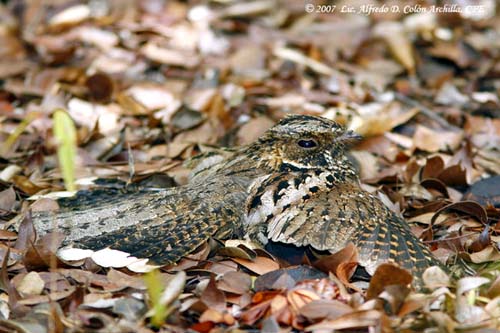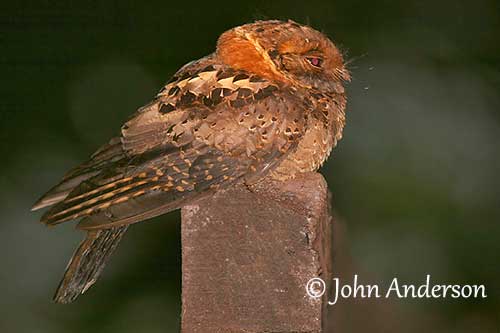
Text by Nicole Bouglouan
Photographers:
Roger Ahlman
Pbase Galleries Peru and Ecuador
John Anderson
John Anderson Photo Galleries
Didier Buysse
Vision d’Oiseaux
Alfredo Colón
Puerto Rico Wildlife
Ken Havard
My Bird Gallery & Flickr gallery 1 & Flickr gallery 2
Patrick Ingremeau
TAMANDUA
Eduardo Andrés Jordan
MIS AVES – AVES DE ARGENTINA
Tom Merigan
Tom Merigan’s Photo Galleries
William Price
PBase-tereksandpiper & Flickr William Price
Dubi Shapiro
Dubi Shapiro Photo Galleries
Simon Tan
PBase Bird galleries
Alan & Ann Tate
AA Bird Photography
Ingo Waschkies
Bird Photography
Sources:
HANDBOOK OF THE BIRDS OF THE WORLD Vol 5 by Josep del Hoyo-Andrew Elliott-Jordi Sargatal - Lynx Edicions - ISBN: 8487334253
NIGHTJARS - A Guide to Nightjars and Related Nightbirds – Nigel Cleere and Dave Nurney - Yale University Press - First Edition (August 11, 1998) - ISBN 10: 0300074573 / ISBN 13: 9780300074574
Animal Diversity Web (University of Michigan Museum of Zoology)
CREAGUS - NIGHTJARS - Caprimulgidae
Fatbirder - Caprimulgidae – Nightjars & Nighthawks
BIRDS of THE WORLD - An Online Bird Book
The influence of moonlight on the behavior of goatsuckers (Caprimulgidae)
Britannica.com - Caprimulgiform
Wikipedia, the free encyclopaedia
FAMILY CAPRIMULGIDAE
CAPRIMULGIFORMES ORDER
Nightjars and Nighthawks
Caprimulgidae is the family of nightjars and nighthawks.
These birds are nocturnal or crepuscular aerial insectivores, feeding mainly on moths and large flying insects.
They are medium-sized, with long wings, short legs and short bill. All species have a very cryptic plumage, allowing them to be invisible while nesting on the ground or perching along a branch, rather than across it. They nest on the ground where the female usually lays two cryptically coloured eggs directly on the sandy soil, leaf litter, rock or bare ground.
Nightjars frequent a wide variety of habitats from deserts to rainforests, although they are mainly found in open country with scattered vegetation. They can be seen from sea-level to 4,200 metres of elevation depending on the range. They inhabit all continents except Arctic and Antarctic, and are present on several islands.

An ancient folk tale goes that the nightjars seen flitting about the goats at night, sucked milk from their udders with their large mouths, giving them the name of “goatsuckers”. But they only were attracted by the numerous insects present around the livestock during the night.
Today, the name “goatsucker” is often replaced by nightjar or nighthawk, a more appropriated term derived from the bird’s voices. Many of them utter startling, strange but beautiful sounds. Their nocturnal calls are often surrounded by an aura of mystery that elicits interest but also fear from humans.
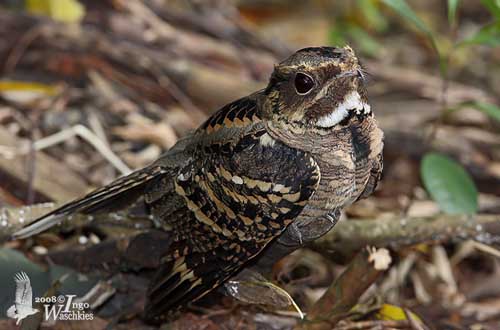
There are two subfamilies: the Chordeilinae with 20/21 species named nighthawks (not related to true hawks) and native to the western hemisphere, and the Caprimulginae named typical nightjars with 77/85 species (one extinct), also named goatsuckers. They are found all around the world.
Subfamily Chordeilineae:
The genus Chordeiles includes six small or medium-sized species in the Americas. They lack rictal bristles around the gape. They are partially diurnal.
The genus Lurocalis has two species found in South America. They are partially arboreal and known to breed and roost in trees. They lack rictal bristles around the gape and white markings on the wings.
The genus Nyctiprogne has two species found in the Amazon Basin. They have small bill and rather concealed nostrils. They lack rictal bristles around the gape and white markings on the wings.
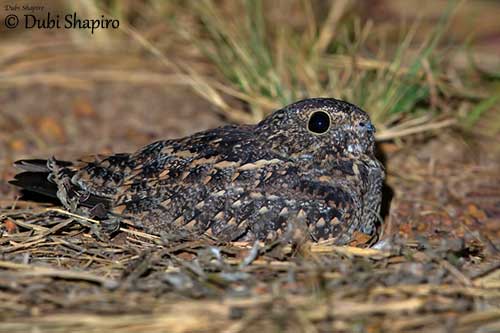
Subfamily Caprimulginae:
The genus Caprimulgus contains the typical or “true” nightjars. It is the largest and the more widespread worldwide (with the highest number in Africa).
The genus Antrostomus is found in E temperate North America to Mexico, and S to Peru, Brazil and the Guianas.
The genus Eleothreptus contains two species of SC South America.
The genus Eurostopodus has seven species found in India, through South-East Asia, to New Guinea and Australia. These nightjars lack pronounced rictal bristles around the gape. Two species have dense clumps of elongated feathers on each side of the hindcrown forming ear-tufts.
The genus Gactornis is endemic to Madagascar.
The genus Hydropsalis occurs in the Amazon Basin and more generally in South America. They have distinctive “trident-shaped” tails, which are mainly conspicuous in males.
The genus Lyncornis includes two species found in SE Asia.
The genus Macropsalis is found in SE Brazil and NE Argentina. The male has extremely elongated outermost rectrices.
The genus Nyctidromus has two species found in the Americas. They have mainly terrestrial habits.
The genus Nyctiphrynus contains four small, Neotropical species (Central and South America). They have long, decurved rictal bristles and dense crown feathers.
The genus Nyctipolus has two small species found in South America in the Amazon Basin and NE Brazil.
The genus Phalaenoptilus contains one small, Nearctic partially migratory species.
The genus Setopagis has four species found locally in South America.
The genus Siphonornis has two small species, endemic to islands in the Caribbean, one on Hispaniola, the other on Jamaica, the latter probably extinct. They have broad, flat bills with decurved tips, prominent nostrils and long, bare tarsi.
The genus Systellura contains two South American species, with one found only along the coast of Peru and N Chile.
The genus Uropsalis includes two beautiful species with elongated tail feathers, both found in W slope of the Andes of NW and WC of South America. The males have very long outermost rectrices.
The genus Veles with only one species is found in Africa, in Liberia and E to Zaire.
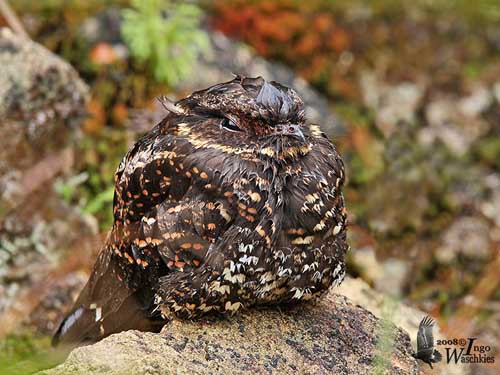
The Caprimulgidae are medium-sized birds with a length of 14 to 55 centimetres and a weight of 30 to 150 grams. They have cryptic plumage. Upperparts and breast are usually a mixture of brown, grey, white, black, buff, tawny, rufous and cinnamon with darker spots, speckles, streaks and vermiculations. The lower underparts are often paler with brown bars.
In numerous species, the males show large, white markings on wings, tail and throat. These markings are used and exposed during territorial defence, courtship displays and distraction displays at the nest-site. The birds have generally long, slender wings with pointed tips, but some species such as the poorwills, have shorter, broader and more rounded wings.
All nightjars are superb, agile and buoyant fliers, due to the very large wing area related to the body weight, while the tail is used as rudder in flight. These morphological details allow them to pursue and capture highly mobile flying prey, mainly insects.
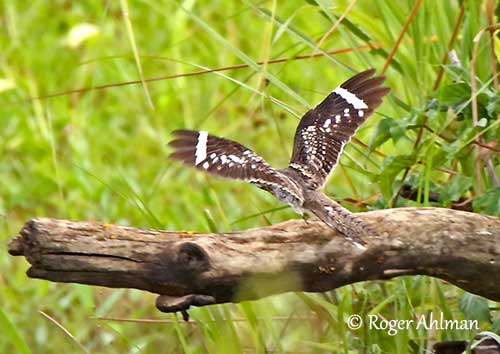
In the two species of the former genus Macrodipteryx, today included in the genus Caprimulgus, the males have some very long wing feathers. The Standard-winged Nightjar has extremely elongated second innermost primaries, which are webbed only at tip, forming “standards” or flags.
The Pennant-winged Nightjar has whitish, elongated second innermost primaries forming “pennants”.
Some species such as the Ladder-tailed Nightjar, the Scissor-tailed Nightjar, the Lyre-tailed Nightjar, the Long-trained Nightjar and the Swallow-tailed Nightjar have unusually shaped and/or elongated outer tail feathers, conspicuous in breeding males.
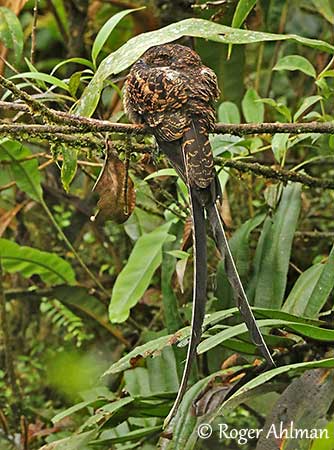
Swallow-tailed Nightjar
Uropsalis segmentata
The chicks have pale grey to brown down at hatching, but their feathers grow very quickly and they look fairly similar to their parents.
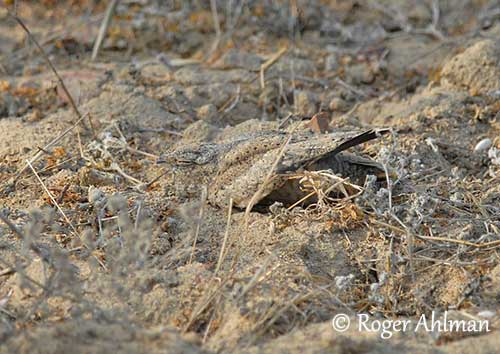
The head may appear fairly large. The bill is very small and weak-looking, but they have an enormous gape and can open their mouths both vertically and horizontally, thanks to a specialized spreading mechanism of the lower jaw. They also have raised nostrils along the top and towards the rear of the upper mandible. The gape is surrounded by very long and probably tactile rictal bristles (except the nightjars of genus Erostopodus).
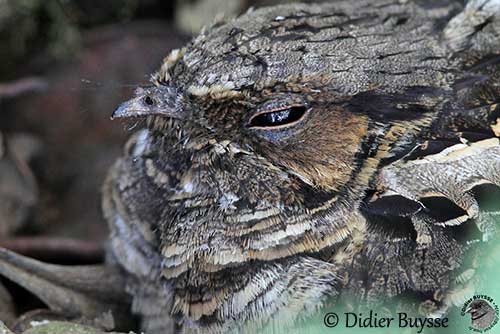
The eyes are fairly large and placed laterally on the head. A unique morphological feature is seen only at night: the distinctive “eye-shine” noticeable when the birds are seen in artificial light. This feature named “tapetum” helps to increase the amount of light entering the eyes, involving better vision at dusk and dawn, and during moonlight nights.
These features are a beautiful adaptation to the nocturnal feeding behaviour of these birds.
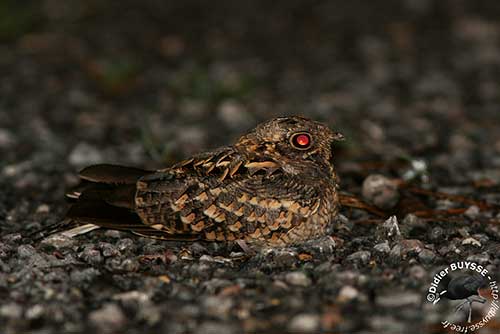
Indian Nightjar
Caprimulgus asiaticus
Most nightjars have short legs and small, weak feet, but many species are able to walk strongly on the ground.
The Pauraque has longer tarsi and is considered to be the most terrestrial of all species.
All members of the family have partly webbed toes. This small, comb-like structure is placed on the inner side of the claw. Its use is not well known, but it could be used to remove parasites or straightening out the rictal bristles during preening and cleaning of feathers.
These extraordinary birds are endowed with numerous morphological criteria intended to facilitate their life on the ground and their aerial foraging behaviour.
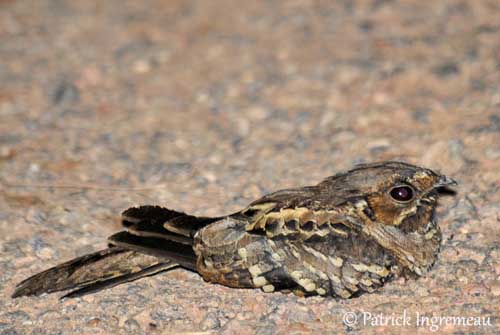
The nightjars are mainly distributed in warm climates throughout the world. In regions where there are seasonal periods, they breed during the summer and move to escape the winter.
The most suitable habitats for these species need broken cover in which they can roost and rear their chicks. The Caprimulgidae occur in all types of habitats from deserts to rainforests. However, they prefer semi-open country with trees and bushes, and areas where some water is available.
They can be found from sea-level (on or near beaches and shorelines) up to about 4,200 metres of elevation.
Some species are living in mountainous regions in New Guinea and South America (S Venezuela, NW Brazil and Andean locations). Among them, we can find the Scissor-tailed Nightjar, the Lyre-tailed Nightjar and the Rufous-bellied Nightjar.
Several species frequent deserts and semi-deserts with little vegetation, and have adapted to living in harsh conditions, mainly in Africa and Asia.

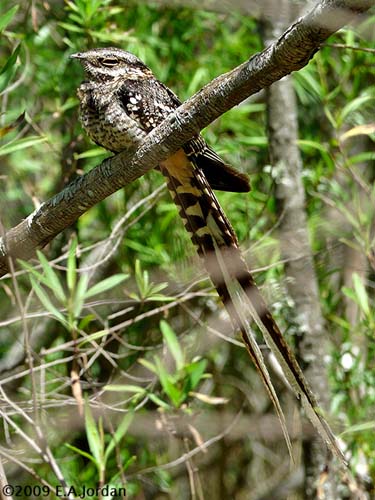
A few specialized nightjars are found in savannas and other grasslands, and areas near to swamps or marshes. Two uncommon species such as the Sickle-winged Nightjar and the White-winged Nightjar, and the more widespread Swamp Nightjar frequent this type of habitat in which they need low structures (bushes or termite mounds) to perch on or to sing or display from. But they are often forced to move as these regions are subjected to fires, flooding, intense grazing and destruction for agricultural expansion.
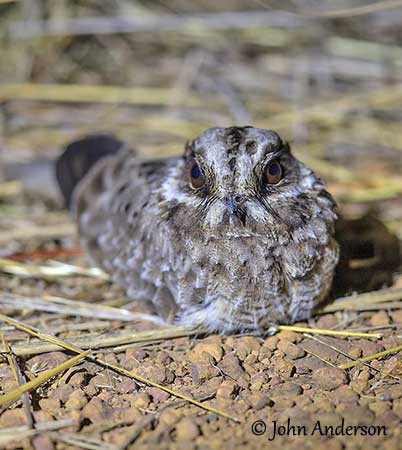
White-winged Nightjar
Eleothreptus candicans
The Blackish Nightjar and the Freckled Nightjar are often observed on rocky terrain or boulders, and they lay their eggs directly on rock surface.
Others spend a large part of their time near cliffs where they hunt from the cliff face. They also frequent rivers and streams. In South America, the Sand-coloured Nighthawk and the Ladder-tailed Nightjar breed and roost on sandbars and riverbanks.
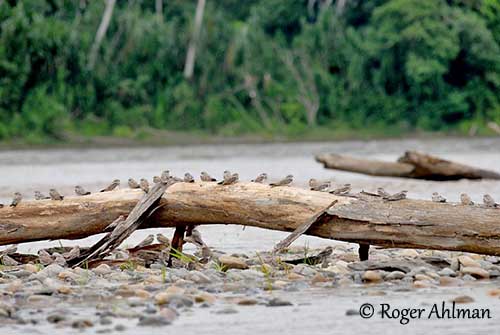
Generally, nightjars tend to remain away from man-made habitats, but a few species may exploit new opportunities and occur near artificial lights and in animal corrals where livestock attracts large numbers of insects at night.
The Common Nighthawk regularly nests on gravel-topped roofs and catches insects attracted by the light of the street lamps. In all countries, the nightjars may nest on roofs, but less often than the previous species.

Nightjars are able to adapt to local environmental conditions, depending of the habitat type. Species living in warmer climates often roost and nest in open areas where they can be affected by long periods to direct exposure to the sun.
In this case, they are able to keep cool and lose heat through gular fluttering. The mouth is opened while the gular area is vibrating, involving the increase of the rate of blood flow to the buccal area.
The Lesser Nighthawk is able to maintain the brain temperature lower than the rest of the body by way of heat exchange through a highly vascularized region in the temples.
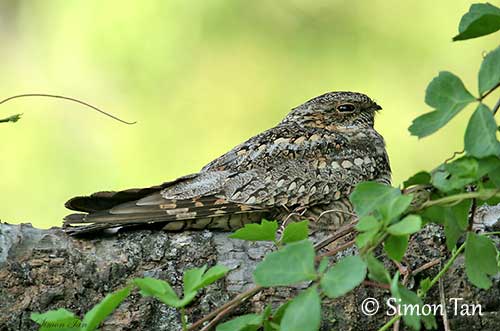
Some species may suffer periods of cold weather affecting their level of activity but also that of their prey. They have the physiological ability to lower their body temperature and become capable of entering and arousing from torpor.
From an observation, the Common Poorwill was found in apparent state of hibernation in the Chuckwalla Mountains in California (December 1946). Native peoples such as the Hopi Indians probably knew of this before, as the bird was named “Hölchko” meaning “the sleeping one”. It is also known to enter prolonged periods of torpor, often referred to as hibernation, because it needs to survive poor weather conditions during the non-breeding season. This state may last for days or even weeks at a time, with lowered body temperature, heartbeat and rate of breathing.
The nightjars are nocturnal birds that become more active at dawn and dusk and during the night, especially during periods of strong moonlight.
However, a few species can be seen active during the day, such as the Sand-coloured Nighthawk which is probably the most diurnal species of all of them. They are very gregarious and often feed, roost and nest communally on riverbanks or sandbars to avoid terrestrial predators.
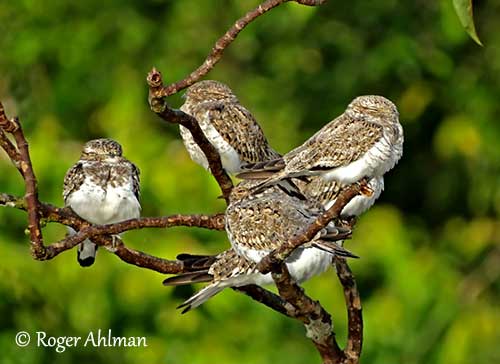
The nightjars usually leave the roost-site during the twilight period of dusk or slightly earlier in overcast weathers conditions. They almost always return to the roosting sites before dawn.
Most of them roost on the ground, usually on the leaf litter, but they are also found on bare soil, sand, pine needles, rocks and boulders, tree stumps, logs, roots and tree branches, occasionally on artificial surfaces. They may rest on branches, either along or across it.
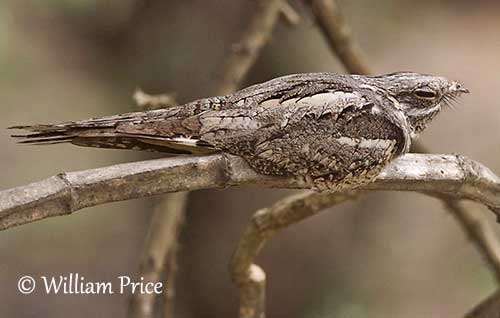
They choose a site where their cryptic plumage blends in with the surroundings, but also where they have a good view of approaching intruders. The roost-site is used day after day, but they change if they have been disturbed. They often roost alone, but both members of a pair often roost together. Outside of breeding season, numerous species may roost in groups at favoured sites.
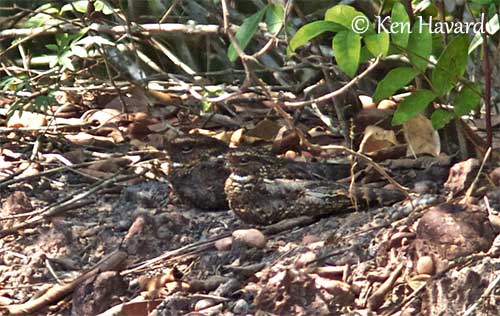
If a nightjar is disturbed at roost-site, it assumes a “vanishing” posture by slowly flattening itself to the ground and closing the eyes until they are almost fully shut. But it remains alert and keeps an eye on whatever is moving around it, through the slit between the eyelids. If an intruder is too close, it immediately takes flight and moves away from the site, before to re-alight quickly, and adopts again a flattened posture.
Nightjars are threatened by hawks and falcons, but also by large owls.
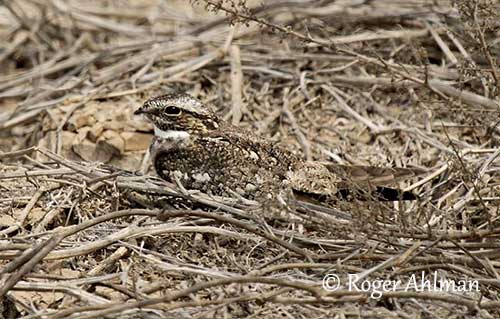
The Caprimulgidae are generally insectivorous, but their diet and foraging habits are poorly known. They remain among the most poorly known of all birds as they are difficult to find and to observe.
They feed primarily on nocturnal flying insects caught and swallowed in flight. But numerous nightjars also catch insects from leaves, branches and logs, and even from the ground.
Most species forages at dawn and dusk, probably helped by their long rictal bristles around the gape, allowing them to locate and lead prey into the mouth. They chase after flying prey thanks to their extremely agile flight interrupted by sudden twists and turns, rises and descents. While hunting, they may hover and swoop down to catch a prey. Between chases, they can be seen gliding around with the wings in V-shape above the body.
The nightjars of genus Chordeiles often hunt in faster, more erratic flight interspersed with short glides.
The larger species often forage very high up, at about 150-175 metres above the ground. They usually forage alone, although during migration and non-breeding period, groups of up to 20 and more birds of mixed species may gather at abundant food sources.
Both Common Nighthawk and Lesser Nighthawk often forage in large flocks of several hundred birds.
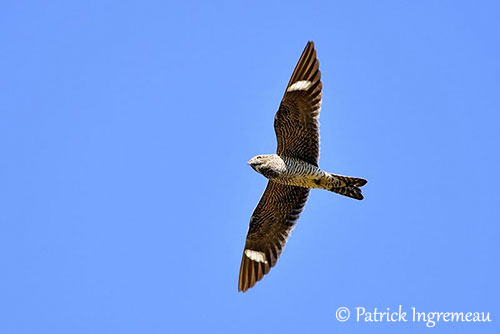
Nightjars also hunt in wait-and-see technique when the light is lower later in the night, flycatching from a perch or from the ground as soon as an insect comes within their range, and then return to the same perch or a nearby one.
They also feed on the ground by running and darting after food, but this behaviour is uncommon. However, for the Chuck-will's-widow that undergoes a rapid moult on the breeding grounds, hunting on the ground is a valuable survival at this time because it is unable to fly strongly. The Pauraque which has relatively long tarsi is more adapted to a terrestrial life style than other species, and the poorwills of genus Siphonorhis also perform ground-feeding, but they are poorly known.
The nightjars drink by gliding low over water with the wings in distinctive V-shape, while skimming the water surface with wide open bill. They also may repeatedly dip the bill into the water while flying. They prefer lakes, ponds and slow-moving rivers rather than fast-moving waterways.
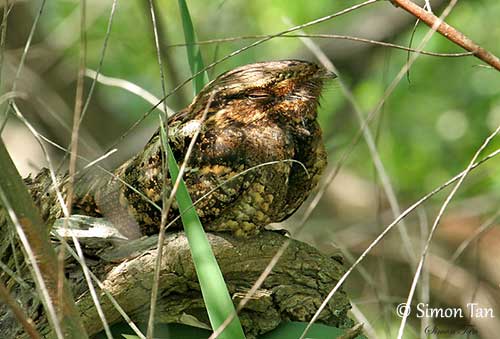
Nightjars are very good fliers, and their agile and buoyant flight allows them to hunt flying insects.
The Lesser Nighthawk patrols the sky alone or in groups, alternating snappy wingbeats, fast flutters and short glides with the wings held in V. The flight is fast on long, pointed wings, with erratic twist and turns and changes of direction.
While hunting, the flight is frequently interspersed with twists and turns, wheels, ascents and descents. The bird also glides around between chases, with the wings held in V-shape above the body.
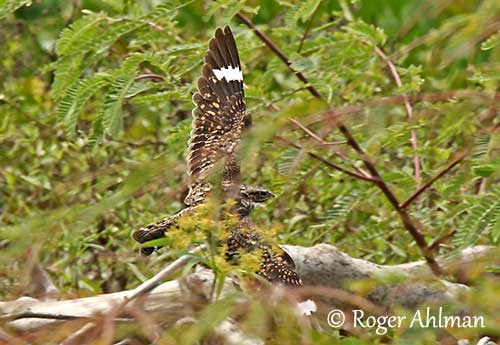
The courtship rituals may occur on the ground or a perch, but they take place more commonly in the air.
They perform aerial courtship displays during which the males usually expose their prominent white markings on throat, wings and tail.
Other species such as the Standard-winged Nightjar and the Pennant-winged Nightjar spread their elongated wing feathers. The flight-display is undulating in order to enhance these long feathers. The elongated second primaries are fluttering behind the bird in flight. The Pennant-winged Nightjar also displays from perches, spreading the wings and slowly circling around on the perch while vibrating the “pennants”.
The Scissor-tailed Nightjar performs courtship displays using the long tail with the beautiful elongated outer rectrices. Displays often occur on the ground, in open patches. Male opens and closes rapidly the wings, producing snapping sound, while it hops into the air. The long tail follows these movements, adding something “aerial” to these displays.
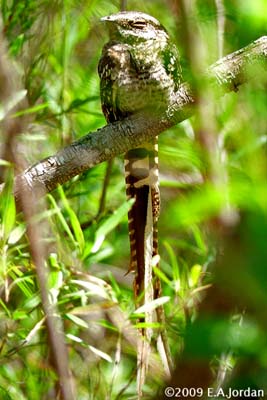
The Lyre-tailed Nightjar performs beautiful aerial displays at night. These flight displays occur at communal aerial lek where one or several males circle and call at, or chase one or several females that join them. The males hover and flick their elongated rectrices to and fro.
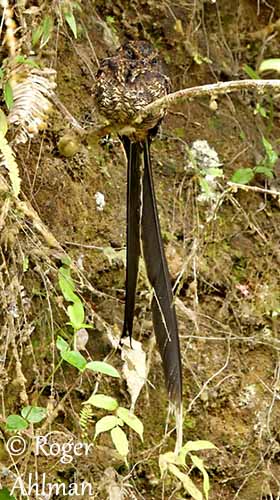
The Sand-coloured Nighthawk performs courtship displays on the ground. The male stretches the neck up vertically and inflates the white feathers of the throat. It walks and approaches the female with fanned tail, swaying from side to side. Then, it stops abruptly and stretches its body horizontally, until touching the ground with the inflated throat. The tail is still fanned. The wings are usually raised during the displays, in order to expose the underwing pattern.
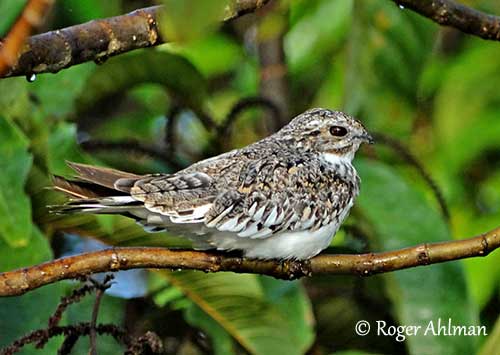
Some displays start on the ground, but then, the male takes flight, circling and fluttering around the female before to alight again. During these short flights, the wings are held at body level while the wingtips are quivering.
Some species such as the Puerto Rican Nightjar display on tree branches or elevated perches where both mates sit parallel about 50 centimetres apart. While singing, the male’s body is vibrating, the wings are drooped and the tail is fanned. Then, the male walks slowly towards the female.
The copulation usually follows a successful display.
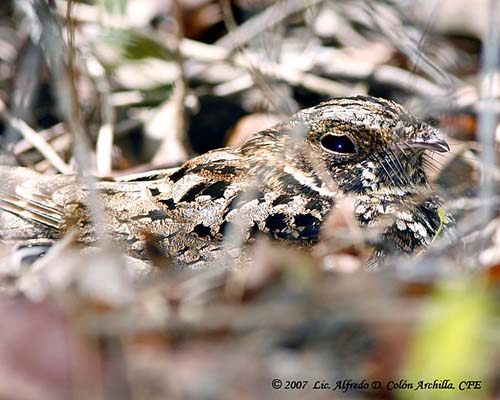
Following pair formation and copulation, the males establish a territory by singing from different places along an invisible boundary.
Although nightjars may appear silent and mysterious, they have a large repertoire of calls. They become more vocal at the beginning of the breeding season.
Males of all species give advertising calls or songs from perches, in flight or from the ground. Mechanical sounds can be heard in some species, especially clapping or booming sounds made with the wings.
The male produces an advertising call to attract a mate and to proclaim the territory. This is very important as their main activities take place at night. They sing from high perches such as tree branch, fence post, wires, rooftop or boulder. Others also sing in flight or from the ground.
Nightjars seem to have the bill closed when singing. The sounds are projected in different directions as the bird turns about on one perch, or flies around its territory while calling from different places.
They call mainly at dusk and dawn, but they also sing throughout the night, especially in full moonlight. They sing strongly before and at the beginning of the breeding season, and less often later, once the pair-bond has formed and the eggs have been laid.
Males of several species have a white throat patch which is conspicuously displayed and puffed out at each call note. This white patch is used as visual signal to potential mates or rival males.
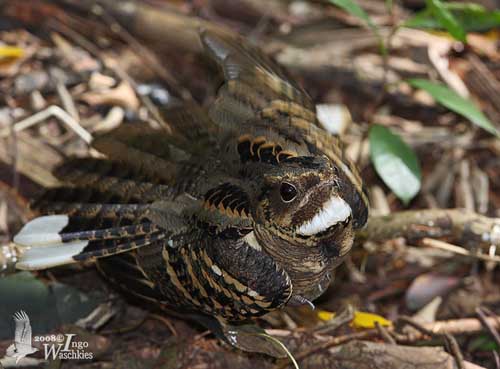
The commonest advertising call is a monotonous sound often referred to a “churring” rapidly repeated in long series of identical notes. These “churrs” may vary in pitch or are interspersed with other notes.
Other advertising calls are mostly whistled forms. These songs vary greatly from rather simple to more complex sounds, and some species give more musical whistles.
Some examples:
Ladder-tailed Nightjar: SOUNDS BY XENO-CANTO
Blackish Nightjar: SOUNDS BY XENO-CANTO
Chuck-will's-widow: SOUNDS BY XENO-CANTO
Common Nighthawk: SOUNDS BY XENO-CANTO
European Nightjar: SOUNDS BY XENO-CANTO
Pauraque: SOUNDS BY XENO-CANTO
Ocellated Poorwill: SOUNDS BY XENO-CANTO
Satanic Nightjar: SOUNDS BY XENO-CANTO
But other types of sounds are produced by other species, including knocking sounds, or like a ball bouncing on a hard surface, but also high-pitched, insect-like or bat-like twitterings, and songs consisting of series of “bubbling” notes.
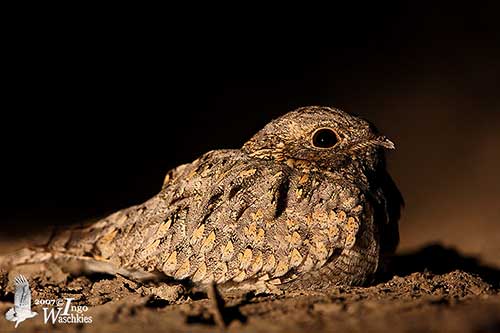
Sykes's Nightjar
Caprimulgus mahrattensis
Several species have distinct flight calls given as contact with other birds of the same species. The contact calls often consist of clucking, croaking, chattering, twittering or whistling sounds.
At the nest-site, the sounds are softer and lower such as murmurings, cooings, churrs, rattles, nasal “pinks” and throaty hisses. The chicks produce soft peeping or cheeping sounds.
If a nightjar is alarmed or threatened, it gives loud, guttural hissing sound rising slowly in pitch and volume while the huge gape is opened. This type of sound is given during defence or distraction display at the nest-site.
Nightjar’s songs are often the only way to locate the birds in the darkness. Numerous different types of calls are used in different contexts, but the primary song which differs between species is the best way to identify the bird, and it is also used by the birds themselves for mutual recognition.
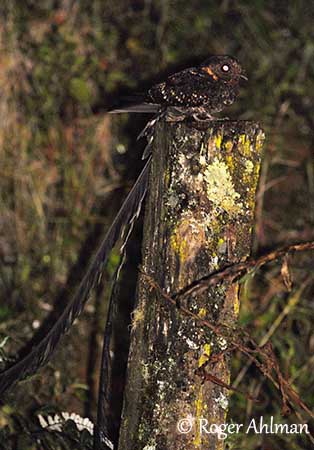
Once a territory is established by a male, the owner defends it strongly against rival males, and mainly during the first part of the breeding season. Aggressive behaviour involves singing towards the neighbouring singing male or aggressive posture with dropped wings and fanned tail, but there is sometimes physical contact in extreme territorial dispute. Two males fly at each other while hitting out with the wings and bill-grappling. These fights may take place on perches or in the air. Both birds may fall to the ground before breaking off and go their own ways.
The nightjars often nest in dry, open areas. The nest-site is often placed near or among vegetation, rocks or stones, logs or fallen branches offering some protection against both bad weather and predators.
These species do not build a nest. The eggs are laid directly on bare ground, leaf litter, or rocks, gravel or sand.
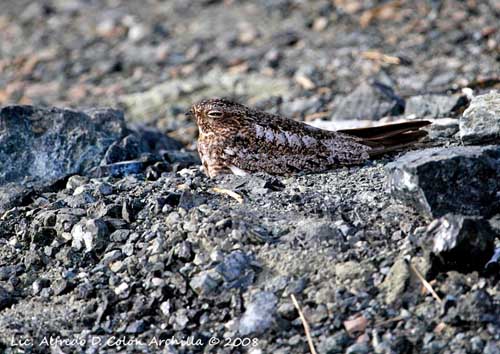
Some species, among them the Blackish Nightjar, choose to nest on rocks. Depending on the nest-site, the eggs laid on open rock may become overheated if the adults are absent for long period. On the other hand, the egg laid in shallow depression in rock may be totally immersed in rainwater during showers. However, the immersed egg is still incubated because the water evaporates quickly from the warm rock.
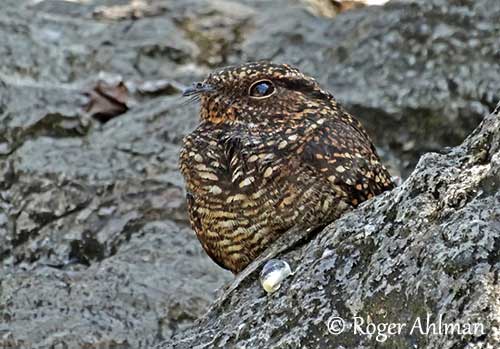
However, a few species are known to nest off the ground. The Brown Nightjar may lay the eggs on a palm frond, whereas the Collared Nightjar nest-site is established within two metres above the ground, often in epiphytic fern on tree trunk.
Other species such as the Band-winged Nightjar, the Common Nighthawk and the Madagascar Nightjar nest on the roof of buildings in several parts of the world.
As a colonial nester, the Sand-coloured Nighthawk breeds communally with up to 200 pairs close to each other on beaches and sandbars.
The Antillean Nighthawk may occasionally nest in loose colonies with the Common Nighthawk. The nest is on the ground, on gravel or sand, in open patch among pebbles or small stones, sometimes in cavity in some coral rock.
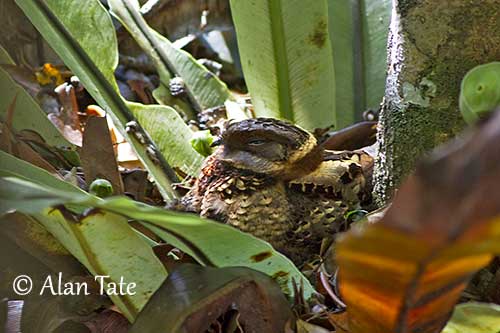
The clutch usually contains one or two eggs, but three or four eggs have been recorded for a few species such as the European Nightjar. However, this is very rare and could be the result of two females laying at the same nest-site.
The eggs are laid at intervals of 24-48 hours. They are whitish, although in some species, they have brownish or pinkish colour. Several darker markings such as spots, blotches, speckles are visible at the larger end.
The pale-coloured eggs are easier to find in the dark for the parents, but they also attract predators during the day. To avoid this problem, the birds remain on the eggs as long as possible during the incubation.
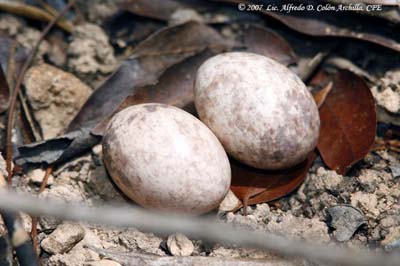
This period lasts about 16-22 days in most species, and the eggs hatch asynchronously. The chicks are covered in greyish, buffish, brownish or reddish down, but their plumage is less cryptic than that of the adults until the first set of feathers is grown. Some chicks remain around the nest-site until they fledge, whereas others may move fairly long distances (10-20 metres each night) and often change of locations every night.
The adults trigger these movements by landing nearby and calling. The chicks respond by walking, running or hopping over their parents to be fed. The chick grabs the bill of the adult and then, it is fed by regurgitation of balls of insects into its mouth, or by taking the food itself from inside the adult’s mouth. After feeding, they are brooded at the new site.
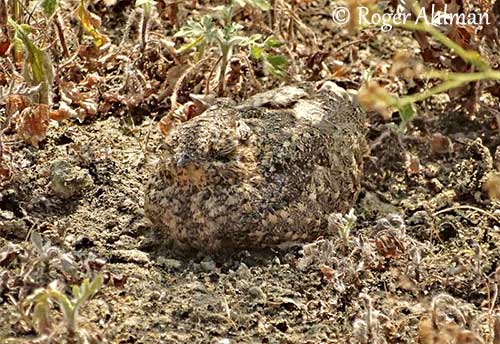
The chick’s plumage becomes more cryptic at about 5-7 days old and the feathers grow quickly. At this period, it is less brooded during the day and can be left alone for long periods. But one or both adults often roost close to the young bird.
If it is threatened, it adopts a flattened posture and remains completely motionless with closed eyes. At this moment, one adult performs distraction display, often the “broken-wing” display, while uttering guttural hisses. But other displays are also performed in flight.
However, the older chicks may perform a threat display by standing upright with the wings stretched out, gaping widely and giving throaty hissing sounds. They also try to escape by fluttering away along the ground.
The nightjar chicks often take their first flight and fledge during the third week. They are independent about 25-35 days after hatching, but they remain in family groups for many weeks.
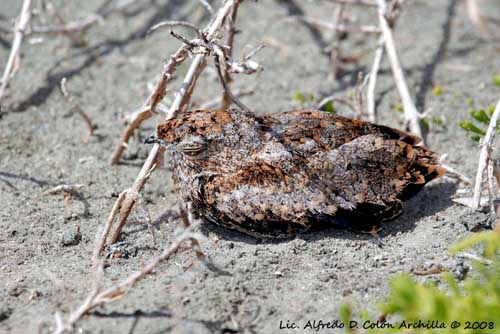
Movements and migrations of nightjars usually take place at night, involving lack of information.
The species living in the northern temperate zone are long-distance migrants. The Common Nighthawk from Canadian and North American populations spends the winter in South America. The Asian populations of the European Nightjar winter in SE Africa.
The status of many Central and South American nightjars is largely unknown. The few species that breed high in the Andes perform some altitudinal movements after breeding. In the south of the continent, a whole range of species move south for the austral summer, with some species breeding as far south as Patagonia. They return north during the winter.
In Africa, a few E African species are partially migratory. They breed in parts of Arabian Peninsula and the Middle East, while others move among savannas between the Sahara Desert to the north, and the forest zone to the south. Some southern species are often influenced by seasonal rains and have complex migrations.
Asian species of genera Eurostopodus and Caprimulgus are migratory in the northernmost parts of their ranges.
In Australia, some populations only perform north-south movements, but small numbers are found in New Guinea during the non-breeding season.
The nightjars breeding in New Guinea are not migratory, like the island species and subspecies throughout SE Asia and W to the Indian Subcontinent.

Band-winged Nightjar
Systellura longirostris
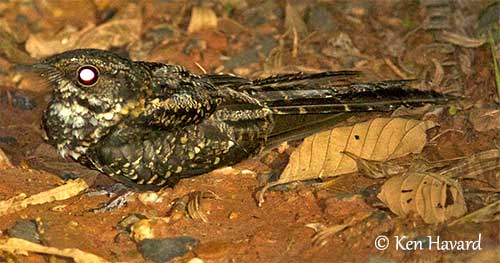
Long-trained Nightjar
Macropsalis forcipata
Like numerous bird species, the Caprimulgidae are affected by habitat destruction, urbanisation, increasing traffic on roads and tracks where they like to rest after dark, reduction of insect populations caused by pollution and pest-control methods in some parts of the range.
Eggs and chicks are vulnerable to predators including snakes, lizards, diurnal raptors, owls and numerous carnivorous mammals. On islands, they are vulnerable to introduced predators such as cats, dogs, rats and mongooses.
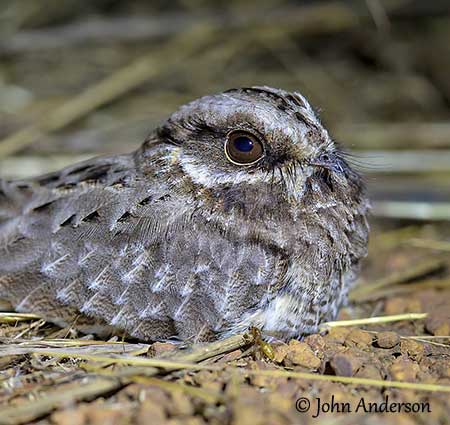
White-winged Nightjar
Eleothreptus candicans
Nightjars are not globally threatened, although several species are affected by habitat destruction and introduction of predators. Two Caribbean species are very rare. The Jamaican Poorwill may well be already extinct, whereas the Puerto Rican Nightjar is restricted to small fragments of native forest in Puerto Rico.
In addition, nightjars often roost or rest on roads where they are often killed by cars.
But currently, numerous species are fairly common or locally common throughout their ranges.
